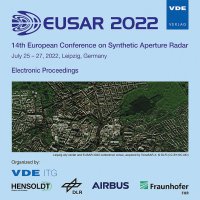Deep Learning for Mapping Forests with TanDEM-X
Konferenz: EUSAR 2022 - 14th European Conference on Synthetic Aperture Radar
25.07.2022 - 27.07.2022 in Leipzig, Germany
Tagungsband: EUSAR 2022
Seiten: 6Sprache: EnglischTyp: PDF
Autoren:
Bueso-Bello, José-Luis; Carcereri, Daniel; Gonzalez, Carolina; Martone, Michele; Rizzoli, Paola (Microwaves and Radar Institute, German Aerospace Center (DLR), Wessling, Germany)
Inhalt:
In a bistatic SAR system such as TanDEM-X, characterized by the absence of temporal decorrelation, the interferometric coherence adds valuable information to the common amplitude images, typically acquired by monostatic SAR systems. The interferometric SAR dataset, acquired to generate the TanDEM-X global Digital Elevation Model (DEM), represents a unique data source to derive land classification maps at global scale, such as the TanDEM-X Forest/Non-Forest Map and the TanDEM-XWater Body Layer. Both maps have as main input the interferometric coherence and are based on a supervised fuzzy clustering algorithm and on the watershed segmentation algorithm, respectively. Single images are classified with the corresponding algorithm and a final weighting mosaicking strategy of overlapping coverages is necessary to improve the final accuracy of the generated classification maps. In this work, we now investigate the capabilities of using a state-of-the-art convolutional neural network (CNN) with TanDEM-X interferometric data for forest and water mapping at large scale. An ad-hoc training strategy has been developed to train a U-Net-like architecture, which aims at balancing the training data set with respect all possible acquisition geometries that can be found in TanDEM-X acquisitions. The Amazon rainforest has been used as region of interest (ROI) to compare the improvement in image classification with respect to the reference fuzzy-clustering approach. On forest classification, a significant performance improvement with respect to the clustering approach, with an f-score increase of 0.13, has been measured. This classification improvement of the forested areas, as well as the capabilities of the U-Net to accurately classify water bodies without the necessity of mosaicking overlapping acquisitions to improve the final classification accuracy, make it possible to generate up to three time-tagged mosaics over the Amazon rainforest by utilizing the nominal TanDEM-X acquisitions between 2011 and 2017.


